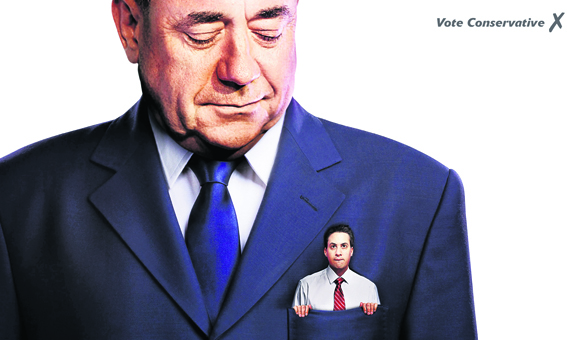The politics of advertising: M&C Saatchi’s Tom Bazeley talks AI and Alex Salmond

In the run-up to the 1997 general election, M&C Saatchi produced an iconic poster for the Conservative Party, which depicted Tony Blair’s face with the eyes of a demon. The strap-line read: “New Labour, new danger”. Though condemned in some corners as negative advertising, the piece won plaudits, though Labour still won in a landslide. For last year’s election, M&C Saatchi produced an equally evocative ad (above), which tapped into the public’s concern using no words whatsoever.
Tom Bazeley sold his independent agency Lean Mean Fighting Machine (LMFM) to M&C Saatchi in 2014 and took up the mantle of chief executive early last year. Since then, the creative shop has been behind some of the most talked about work in the UK, including an artificially intelligent poster campaign which used a genetic algorithm to display different ads depending on the reactions of passers-by.
He talks to City A.M. about whether AI is the future of advertising, and the story behind the Salmond ad.
How was it to sell LMFM to M&C Saatchi?
The business model of advertising and creative agencies is very simple, so managing them is relatively straight forward. The difference comes in how you incentivise people to succeed. M&C Saatchi is a much bigger organisation, and the scale of the relationships we enjoy with our clients is bigger as well. It’s just about applying the same principles on a different scale.
What was your thinking behind the AI posters you installed last summer?
Technology has given rise to unbelievable fragmentation of the media landscape, which can be a pain at times, but it offers a creative agency umpteen shapes of canvas upon which to present and build ideas. The AI out-of-home posters were an example of that, but also of how technology can be used as a provocation. It’s a topic of conversation; the kind of hypothetical between a techie and a creative director down the pub on a Friday night. “If you could have a piece of advertising which was artificially intelligent, could you get rid of the creative department? If you left it running forever, would it become the most persuasive and impactful piece of advertising possible?”
Early last year, we realised that we could make this work. We ran it on Oxford Street for a few weeks, obtained some meaningful data and some crude patterns emerged. I’d be lying if I said the conclusions were really meaningful. We did notice patterns which showed that time of day, day of the week and temperature were affecting the data we received from people.
It wasn’t “the future” then?
In terms of taking technology and subverting it to make an advertising message more memorable and effective, then it absolutely was. That is going to be at the heart of what we do as creative agencies. But we won’t be doing away with the creative department.
You and the rest of the management team recently bought a 30 per cent stake in the London business. What do you hope to achieve?
Restructuring will give us two things. It will bring us in line with the rest of M&C Saatchi more globally, and will offer total clarity on who’s running the agency. It sounds surprising, but when you’ve got a big organisation with lots of experienced people, it can be difficult for staff to know whose neck is on the line for the success of the work. That’s one of the reasons we went public with the announcement. The five of us have absolute faith in the brand, the organisation and the people we’ve got here.
What was your highlight of last year?
About eight weeks before the general election, we did an ad for the Conservative Party which had an image of Alex Salmond with Ed Miliband in his pocket. If an ad has no words on it at all, you’ve got to write it so brilliantly that you get away with it. It has a slight sense of mischievousness to it, which made it rewarding for us. But more important than anything, it set the news agenda for the general election.
We picked up on public concern in some focus groups and wrote some ideas around that, and realised that we could get it onto the news agenda – that if you don’t vote Conservative, there’s a good chance these characters would come in. We have empirical data which monitored the prevalence of stories in UK newspapers related to the issue, and it rose and rose until the election. That is quite humbling for a creative agency – to have come up with a piece of advertising which has played a role in determining who’s running our country for the next five – and let’s face it – probably ten years.